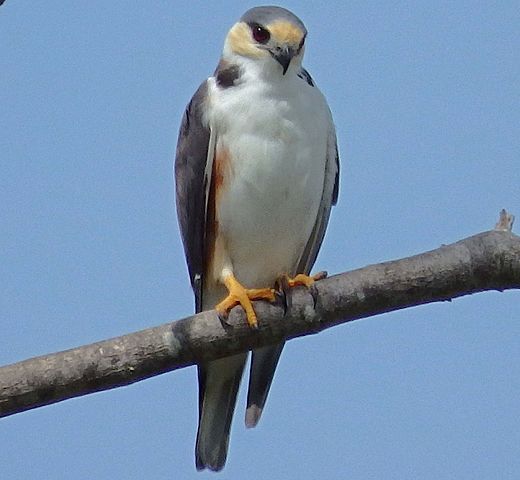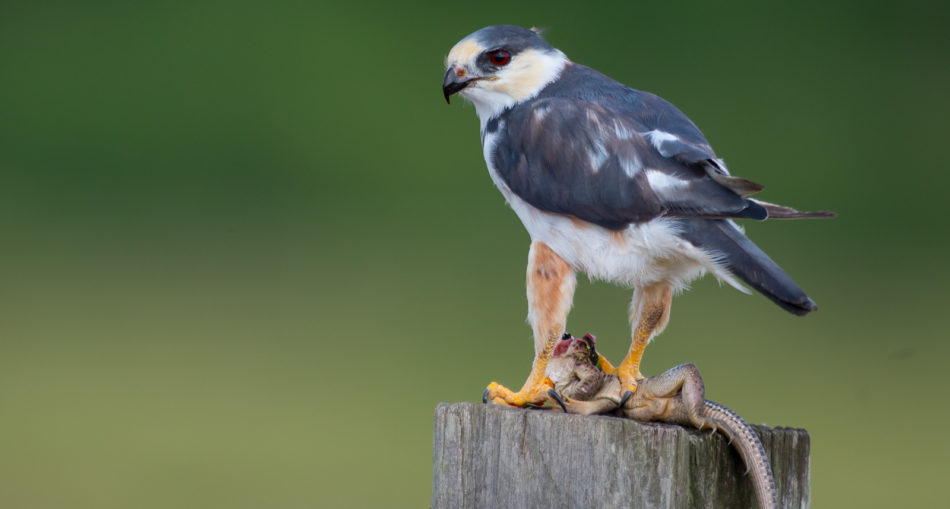The pearl kite (Gampsonyx swainsonii) is a very small raptor found in the Americas. It is found in a wide variety of habitats. They prefer shrubby pastures where they feed mostly on lizards, frogs, and insects. It is the only member of the genus Gampsonyx. The scientific name commemorates the English naturalist William Swainson.

Pearl Kite | By Greg Kanies – Pearl Kite, CC BY-SA 2.0, https://commons.wikimedia.org/w/index.php?curid=45188369
This article tells you everything you need to know about Pearl Kites!
Scientific Classification Of The Pearl Kite
- Kingdom: Animalia
- Phylum: Chordata
- Class: Aves
- Order: Accipitriformes
- Family: Accipitridae
- Genus: Gampsonyx Vigors, 1825
- Species: G. swainsonii
The Pearl Kite has three subspecies.
- G.s. leonae is found in SE El Salvador, S Honduras, W Nicaragua, Costa Rica and Panama. It also occurs in N and E Colombia, through Venezuela and Trinidad to Guyana and Suriname, and S to NE Ecuador and Brazil, N of R Amazon. This race has rufous flanks.
- G.s. magnus is found in W Ecuador and NW Peru. This one has also rufous flanks
- G.s. swainsonii occurs in Brazil, S of R Amazon S to E Peru, N and E Bolivia, Paraguay and N Argentine.
Where Does The Pearl Kite Live?
This tiny kite can be found in Panama, Colombia and Venezuela south to Bolivia and northern Argentina, with an isolated sedentary population in Nicaragua, the Guianas (Guyana). It is present in Trinidad but not its neighbouring island Tobago. They prefer dry savannas, also using open tropical forests and woodlands, second growths, dry scrublands, wet grasslands, agricultural areas and even within urban areas.
What Does The Pearl Kite Look Like?
The pearl kite is 20.3–23 cm (8.0–9.1 in) in length and weighs 80–95 g (2.8–3.4 oz). The wingspan is 45-55 cm. The adult has a black crown, upperparts, wing and tail, a rufous edged white collar, yellow forehead and cheeks, mainly white underparts, and bright yellow legs. The females are 10-20 % larger than males. Immature birds are similar to the adults but have white and chestnut tips to the back and wing feathers, a buff collar and some buff on the white underparts. The eyes are browner in juveniles. In flight, this species looks mainly black above and white below.
Diet Of The Pearl Kite
These tiny raptors feed mainly on lizards, especially Anolis, but also takes small birds and insects; it usually sits on a high open perch from which it swoops on its prey.
Behaviour Of The Pearl Kite
Pearl kites have been known to fly and perch high above the ground, and to catch prey by descending from such heights. It has also been documented that they get in relatively close range to people, unlike some other wild animals. They often fly by themselves, but when this is not the case, they may be seen in pairs. Nests are constructed by both sexes and may be built as high as 25m in the trees. The flight of the Pearl Kite is swift and usually low above the ground. When foraging, it hovers in falcon-like motion.
Call / Song Of The Pearl Kite
Its call is described as a high musical pip-pip-pip-pip or kitty-kitty-kitty.
Reproduction Of The Pearl Kite
Usually, the breeding period for this species is between January and May. However, these birds have been known to also breed in the month of October. During the courtship period, males fly close to the females and tend to flutter their wings. The females then follow in pursuit. On the female side, they tend to make longer, softer notes during this time. Both sexes invest in nest building, using many sticks to create them. The nest is a deep cup of sticks built high in a tree. The females may have between 2-4 eggs with chestnut markings. It is the responsibility of both parents to incubate them until they hatch. This period is approximately 34 days long with a further 5 weeks to fledging. This species may produce two (2) broods per season
Did You Know?
- When these birds have offspring, it is the responsibility of the males to gather food and return with it to the nest.
- Although males acquire the food, it is only the female that feeds the nestlings.
Conservation Status Of The Pearl Kite
The Pearl Kite has benefited from forest clearance, and the species is slowly expanding its range, especially in response to deforestation in some areas. The population is roughly estimated to number 670/6,700 mature individuals. The Pearl Kite is currently evaluated as Least Concern.
Pearl Kites In Guyana
You can find these tiny raptors at the Karanambu Lodge, Rupununi, Guyana. They can also be found in neighbouring countries such as Venezuela, Brazil, Suriname, and on the island of Trinidad. There are three (3) subspecies found in different parts of the world today. These birds feed mainly on lizards but also take small birds and insects.
Article References:
- http://planetbirds.blogspot.com/2014/05/pearl-kite.html
- https://www.beautyofbirds.com/pearlkites.html
- https://neotropical.birds.cornell.edu/Species-Account/nb/species/peakit1/overview
- https://en.m.wikipedia.org/wiki/Pearl_kite
- https://animals.fandom.com/wiki/Pearl_Kite
- Main Image: By https://www.flickr.com/photos/jquental/ – https://www.flickr.com/photos/jquental/13033004483/, CC BY 2.0, https://commons.wikimedia.org/w/index.php?curid=36314077
Discover more from Things Guyana
Subscribe to get the latest posts sent to your email.







